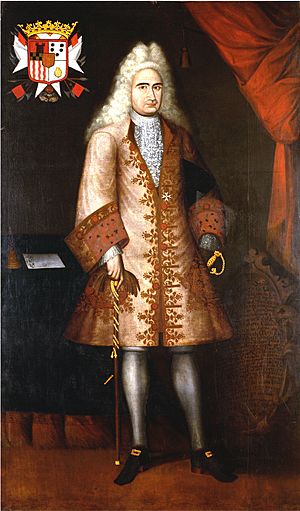Jorge de Villalonga facts for kids
Jorge de Villalonga, also known as the second Count of la Cueva, was a Spanish leader born in 1664. He was a lawyer and a general. He became the very first official viceroy of a large Spanish territory called New Granada. He held this important position from November 25, 1719, until May 11, 1724.
Contents
About Jorge de Villalonga
Jorge de Villalonga was a special knight of the Sovereign Military Order of Malta. He was also a skilled soldier who rose to the high rank of lieutenant general in the army. He worked as a member of the war council and as a lawyer in the Kingdom of Majorca. Later, in Madrid, he married his niece, Catalina María de Villalonga y de Velasco. In 1708, he was put in charge of the port and military fort (called a presidio) in Callao, Peru.
Becoming the First Viceroy
On December 15, 1718, while he was leading the army in Peru, Villalonga received big news. He had been chosen to be the first official viceroy of the newly formed Viceroyalty of New Granada. This new Spanish colony was huge! It included areas that are now the countries of Venezuela, Colombia, Panama, and Ecuador. Before May 27, 1717, this entire region was part of the Viceroyalty of Peru.
Villalonga had a long journey overland to reach his new post. He stopped in cities like Quito and Popayán along the way. On December 17, 1718, he made a grand entrance into Santa Fe de Bogotá, the capital city. His arrival was very impressive to the people living there. However, his fancy lifestyle was quite different from how most people in the city lived, as many were not wealthy.
Challenges and Decisions as Viceroy
One of Villalonga's main jobs was to fix problems and improve how royal officials managed things in the colony. In 1722, he took action against an accountant named Domingo de Mena. His time as viceroy faced some challenges regarding how things were managed.
Villalonga also had specific instructions from Spain. He was told to prevent the growth of local wine-making and textile (cloth-making) businesses in the colony. This was done to protect similar industries back in Spain from competition. In November 1720, Spanish forces attacked a Dutch settlement in Tucacas, which is now part of Venezuela. This area was known for illegal trade. The Spanish largely destroyed it.
In 1721, following orders from the Spanish government in Madrid, Villalonga made all foreigners leave the colony. This included both people who lived there permanently and those just visiting. Even men who were married to women born in the colony had to leave. He also took direct control of the government's money (the treasury). He worked to improve official records of people (the civil registry) and helped start a Jesuit college in the city of Santa Fe de Antioquia.
End of His Term
Viceroy Villalonga often told the King of Spain that the viceroyalty should be ended. He suggested that the old government under Peru should be brought back to save money. He believed the colony was too poor to support a viceroy's government. He noted that there were few Spaniards and many Indigenous people living there.
In September 1723, King Philip V agreed and ordered the change. The two colonies were reunited on May 11, 1724. Villalonga left Bogotá on May 31 of that year. The colonies stayed reunited until 1740. That's when the Viceroyalty of New Granada was created again, this time for good.
See also
 In Spanish: Jorge de Villalonga para niños
In Spanish: Jorge de Villalonga para niños


